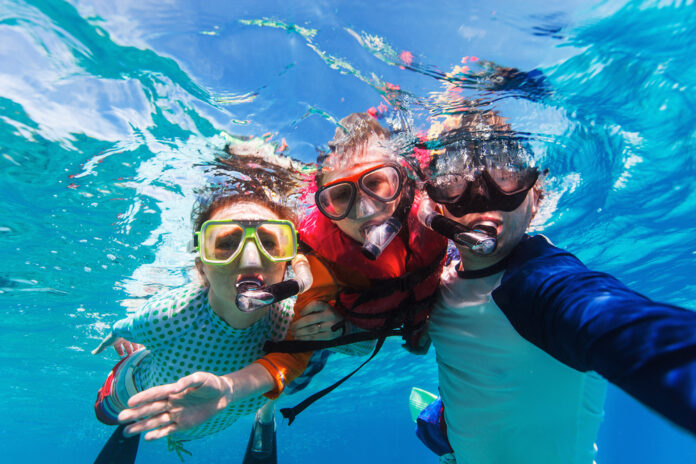Difference Between Snorkeling and Scuba Diving
In the realm of underwater exploration, two popular activities stand out: snorkeling and scuba diving. While both involve immersing oneself in the aquatic world, they differ significantly in technique, equipment, depth, and experience. This blog delves into the difference between Snorkeling and Scuba Diving, explaining the differences and guiding enthusiasts toward the experience that best suits their preferences.
Also Read: Best Places to Visit in Lakshadweep Islands in India 2024
Snorkeling
Snorkeling is a surface-based aquatic activity that allows individuals to observe underwater life while breathing through a snorkel tube. It is often practiced in shallow waters, making it accessible to people of various skill levels and ages.
- Definition and Basics: Snorkeling involves floating on the water’s surface while wearing a diving mask and a snorkel, a breathing tube that extends above the water. Participants can observe underwater environments without the need for extensive training or specialized equipment.
- Equipment:
-
- Diving Mask: Provides clear vision underwater.
- Snorkel: Allows continuous breathing while face-down in the water.
- Fins: Aid in propulsion and maneuverability.
- Technique: Snorkelers use a relaxed swimming motion, keeping their face submerged to breathe through the snorkel. Clearing the snorkel of water and maintaining a steady breathing rhythm are essential skills.
- Depth Limitations: Typically, snorkeling is restricted to depths where one can comfortably surface for air. While some advanced snorkelers may venture to greater depths, it is generally practiced in waters less than 10 feet deep.
- Experience and Accessibility: Snorkeling offers a relatively easy entry point into underwater exploration, requiring minimal equipment and training. It is suitable for individuals of all ages and can be enjoyed in various aquatic environments, including reefs, shallow bays, and calm lagoons.
Scuba Diving
Scuba diving, on the other hand, allows for deeper exploration beneath the water’s surface, facilitated by specialized equipment that enables extended periods underwater.
- Definition and Basics: Scuba diving involves using a self-contained underwater breathing apparatus (SCUBA) to breathe compressed air while submerged. Divers carry tanks of compressed air on their backs, allowing them to explore depths beyond the reach of snorkelers.
- Equipment:
-
- Buoyancy Compensator Device (BCD): Regulates buoyancy and provides stability underwater.
- Regulator: Reduces high-pressure air from the tank to a breathable level.
- Dive Tank: Contains compressed air for breathing.
- Depth Gauge and Dive Computer: Monitor depth and dive time.
- Mask, Fins, and Snorkel: Similar to snorkeling equipment, but often of higher quality and durability.
- Technique: Scuba divers undergo training to learn proper buoyancy control, equalization techniques, and emergency procedures. They use fins for propulsion and employ hand signals to communicate underwater. Monitoring air supply and dive parameters is crucial for safety.
- Depth Capabilities: Scuba diving allows for exploration at much greater depths than snorkeling. Depending on certification level and equipment, divers can safely descend to depths exceeding 100 feet or more, accessing unique underwater ecosystems and encountering marine life rarely seen near the surface.
- Certification and Training: Unlike snorkeling, scuba diving requires certification from recognized training agencies such as PADI (Professional Association of Diving Instructors) or NAUI (National Association of Underwater Instructors). Divers undergo classroom instruction, confined water sessions, and open water dives to learn essential skills and safety protocols.
Key Differences Between Snorkeling and Scuba Diving
- Depth and Duration: Snorkeling is limited to surface-level exploration in shallow waters, while scuba diving allows for deeper dives and longer underwater durations.
- Equipment and Training: Snorkeling requires minimal equipment and no formal training, making it accessible to beginners. In contrast, scuba diving necessitates specialized gear and certification to ensure safety and competency underwater.
- Experience and Accessibility: Snorkeling offers a more casual and accessible experience, suitable for families and individuals seeking a leisurely aquatic activity. Scuba diving provides a more immersive and adventurous experience, appealing to those interested in exploring the depths and encountering diverse marine life.
- Safety Considerations: While both activities have inherent risks, scuba diving requires adherence to strict safety protocols and equipment maintenance due to the complexities of underwater breathing and pressure management.
Also Read: How to Reach Andaman and Nicobar Islands
Snorkeling and Scuba Diving in Andaman
Snorkeling in Andaman
Andaman’s pristine waters and vibrant coral reefs offer exceptional opportunities for snorkeling enthusiasts to witness the underwater splendor up close.
Locations for Snorkeling
- Havelock Island: Popular spots include Elephant Beach and Radhanagar Beach, known for their clear waters and diverse marine life.
- Neil Island: Laxmanpur Beach and Bharatpur Beach are ideal for snorkeling, boasting colorful corals and an abundance of fish species.
- North Bay Island: Home to the iconic North Bay Coral Island, where snorkelers can explore coral gardens teeming with marine biodiversity.
Marine Life Encounters
Snorkelers in Andaman can encounter a rich variety of marine life, including vibrant coral formations, tropical fish species, sea turtles, rays, and occasionally, reef sharks. The crystal-clear waters provide excellent visibility, enhancing the snorkeling experience.
Equipment Rental and Guided Tours
Various tour operators and resorts in Andaman offer snorkeling equipment rental and guided tours to prime snorkeling sites. Visitors can easily arrange snorkeling excursions, complete with experienced guides who provide safety briefings and insights into the local marine ecosystem.
Scuba Diving in Andaman
For those seeking deeper exploration and more immersive experiences, scuba diving in Andaman unveils a mesmerizing underwater world filled with breathtaking sights.
Dive Sites and Highlights
- The Wall at Havelock: Known for its dramatic drop-offs and vibrant coral formations, this site offers encounters with reef sharks, turtles, and schooling fish.
- Dixon’s Pinnacle: Located near Neil Island, this pinnacle dive site is renowned for its towering coral formations, pelagic species, and occasional sightings of manta rays.
- Jackson’s Bar: Situated off the coast of Baratang Island, this site features underwater caves, swim-throughs, and a diverse array of marine life, including colorful nudibranchs and macro critters.
Certification and Training Centers
Several dive centers in Andaman provide scuba diving courses catering to beginners and experienced divers alike. From introductory Discover Scuba Diving programs to advanced certifications such as Open Water Diver and Advanced Open Water Diver, aspiring divers can embark on their underwater journey under the guidance of certified instructors.
Safety Measures and Considerations
Safety is paramount in scuba diving, and certified dive centers in Andaman adhere to strict safety standards and protocols. Divers receive comprehensive briefings on equipment usage, dive site conditions, and emergency procedures to ensure a safe and enjoyable diving experience.
Comparing Snorkeling and Scuba Diving in Andaman
- Depth and Accessibility: Snorkeling in Andaman offers accessible opportunities for surface-level exploration, making it suitable for individuals of all ages and swimming abilities. Scuba diving, while requiring certification and specialized equipment, allows divers to explore deeper depths and encounter a wider range of marine life.
- Experience and Immersion: Snorkeling provides a casual and leisurely way to observe underwater ecosystems, while scuba diving offers a more immersive and adventurous experience, allowing divers to interact closely with marine life and explore underwater landscapes in greater detail.
- Equipment and Training: Snorkeling requires minimal equipment and no formal training, making it accessible to beginners. In contrast, scuba diving necessitates certification and proper training to ensure safety and competency underwater, along with the use of specialized dive gear.
Scuba Diving in India
India’s extensive coastline and diverse marine ecosystems offer a wealth of opportunities for scuba diving enthusiasts to explore underwater wonders.
- Dive Destinations:
-
- Andaman and Nicobar Islands: Renowned for their crystal-clear waters and vibrant coral reefs, the Andaman Islands boast dive sites such as Havelock Island, Neil Island, and Barren Island, offering encounters with reef sharks, manta rays, and colorful reef fish.
- Lakshadweep Islands: With its remote atolls and coral islands, Lakshadweep offers pristine dive sites like Agatti Island, Kadmat Island, and Bangaram Island, where divers can explore coral gardens, underwater pinnacles, and diverse marine life.
- Marine Life: Scuba divers in India have the opportunity to encounter an array of marine creatures, including reef fish, turtles, sharks, rays, and larger pelagic species such as barracudas and groupers. Coral reefs teem with colorful corals, sponges, and reef inhabitants, creating a vibrant underwater ecosystem.
- Certification and Training Facilities: Several dive centers and resorts across India offer scuba diving courses accredited by international organizations like PADI (Professional Association of Diving Instructors) and SSI (Scuba Schools International). From beginner courses to advanced specialties, aspiring divers can undergo training under the guidance of experienced instructors.
Snorkeling in India
India’s coastal regions and offshore islands provide ample opportunities for snorkeling enthusiasts to witness the beauty of underwater ecosystems without the need for extensive training or equipment.
- Prime Snorkeling Spots:
-
- Goa: Known for its sandy beaches and clear waters, Goa offers snorkeling opportunities at locations such as Grande Island, where snorkelers can explore rocky reefs and encounter marine life such as angelfish, parrotfish, and moray eels.
- Kerala: The backwaters and lagoons of Kerala provide tranquil snorkeling experiences, with spots like Varkala and Kovalam offering glimpses of colorful reef fish, sea turtles, and occasional sightings of reef sharks.
- Marine Biodiversity: Snorkelers in India can marvel at the diverse marine biodiversity, from bustling coral reefs to seagrass meadows and rocky outcrops. Coastal waters are inhabited by an array of fish species, crustaceans, and invertebrates, making snorkeling a rewarding experience for nature enthusiasts.
- Accessibility and Equipment Rental: Snorkeling gear such as masks, snorkels, and fins are readily available for rent at beach resorts, dive centers, and water sports operators across popular snorkeling destinations in India. Guided snorkeling tours led by experienced instructors ensure a safe and enjoyable experience for participants of all ages and skill levels.
Conclusion
In summary, snorkeling and scuba diving offer unique avenues for underwater exploration, each catering to different preferences and skill levels. Snorkeling provides a simple and accessible way to observe marine life in shallow waters, while scuba diving allows for deeper immersion and exploration of diverse underwater environments. Whether opting for the tranquility of surface snorkeling or the exhilaration of deep-sea diving, enthusiasts can embark on aquatic adventures tailored to their interests and capabilities. Ultimately, both activities offer enriching experiences that foster a deeper appreciation for the mesmerizing world beneath the waves.
What is the difference between scuba diving and snorkeling?
Scuba diving and snorkeling are both underwater activities, but they differ significantly in technique, equipment, depth, and experience.
- Scuba Diving: Involves diving underwater using a self-contained underwater breathing apparatus (SCUBA) to breathe compressed air from a tank. Divers undergo training and certification to explore deeper depths, typically encountering a wider range of marine life and underwater environments. Scuba diving allows for extended periods underwater and requires specialized equipment such as a buoyancy control device, regulator, and dive tank.
- Snorkeling: This is a surface-based activity where participants float on the water’s surface and breathe through a snorkel tube while observing underwater life. Snorkeling is practiced in shallow waters and does not require formal training or certification. Participants use basic equipment such as a mask, snorkel, and fins, and explore surface-level environments, generally limiting their depth to where they can comfortably surface for air.
Is scuba diving and snorkeling the same thing?
No, scuba diving and snorkeling are not the same thing; they are two distinct underwater activities with different techniques, equipment, and depth capabilities.
- Scuba Diving: Involves diving underwater using specialized equipment, including a dive tank, regulator, and buoyancy control device, to explore deeper depths and encounter a wider range of marine life. Scuba diving requires training and certification and allows divers to stay submerged for extended periods.
- Snorkeling: This is a surface-based activity where participants float on the water’s surface and breathe through a snorkel tube while observing underwater life. Snorkeling is practiced in shallow waters and does not require formal training or certification. Participants use basic equipment such as a mask, snorkel, and fins, and explore surface-level environments without venturing into deeper depths like scuba divers.





